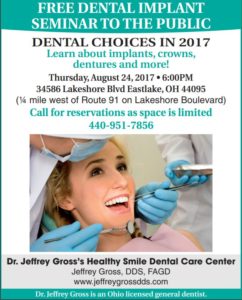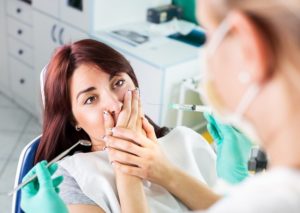I Hate Shots. I Wish That You Would Have Something Else!
Many years ago, just the opposite was stated. Dental anesthesia simply didn’t exist! There was really nothing to numb or deaden a tooth so it could be treated. The first local anesthetic used was actually cocaine. It worked but of course, it was addictive and toxic. It wasn’t until the beginning of the last century that our famous Novocaine came on the scene. In fact, it was so popular that many people today use the word to mean a local anesthetic.
Pain-free dentistry is now a reality!
We really don’t use Novocaine anymore in dentistry as it has been replaced by better anesthetics with fewer side issues. These newer products give better numbing, which we call “anesthesia” and work quicker. It would be an understatement to say that local anesthetic has revolutionized dental care. We can now perform a variety of procedures, whether simple or sophisticated with the patient being totally pain-free.
Before local anesthetic, the only treatment available was the removal of a troublesome tooth and of course was not a pleasant experience for any one. The ability to numb a tooth has led to more people keeping teeth for their entire lives, rather than being toothless in their twenties. So that’s great! We can do a dental procedure in a pain-free environment using a local anesthetic. The problem with this from the patient perspective is how we have to administer it. Of course, I am referring to the dreaded shot.
What is dental anesthetics?
Let’s talk a little about this. The method of action of a local anesthetic is to bathe the nerves that transmit sensation from the tooth to the brain in this numbing liquid. When the nerves come in contact with the solution they shut down and no longer do their job of sending a pain signal. This closed for lunch sign is effective until the anesthetic leaves the area of the nerve and sensation comes back to the tooth.
Different locations of the mouth have different requirements for giving the anesthetic. For the upper teeth, it is given one way. For the lower teeth, it is given another way. The upper jaw is much more porous than the lower jaw. Therefore, simply placing the anesthetic under the gum next to an upper tooth will cause the tooth to numb. The lower jaw is much denser and if you put anesthetic next to a tooth it will not penetrate the jaw and reach the nerves of the tooth. To numb a lower tooth, you have to find the nerve that supplies the entire side of the mouth and numb that. That is why we numb the back of the mouth when we work on lower teeth even though we may be working more towards the front of the mouth.

Did you know? There is now a nasal spray dental anesthetic!
The human body is a marvel of complication, sophistication, and crossovers when it comes to its various parts. Because of this, we now can actually numb many upper teeth without a shot. Yes, that is not a typo! We DO NOT need a shot for a number of upper teeth. Just last year the FDA approved a product called Kovanaze for use in dentistry for upper teeth. The product is a nasal spray that is given prior to performing dental work. It can numb the upper front teeth without the side effect of numbing the lips and cheeks. It is not for all teeth, but one of the most sensitive injections is in the front of the mouth. With this nasal spray anesthetic, those days are history.
Topical dental anesthetic for pain-free cleanings
Many people are sensitive to having their teeth cleaned. Because of this, they skip their very important dental cleanings and checkups and only come when it is too late. I use another product which can be squirted around a tooth without the use of a needle to numb the area. This can make your cleaning totally pain free.
Unlike the nasal spray, I can use this any place in the mouth. It doesn’t make a difference if it is an upper tooth with its porous jaw or a lower tooth with a dense jaw. This product simply works without having to use a shot. This product is called Oraqix (pronounced Ora-Kicks) and I have used it for a number of years to make routine procedures more comfortable and easier. When you are at ease, our work goes faster and is done much better. It is a win-win for all involved.
Today, Dental Anesthesia does not have to mean shots
So although needles have not left medicine, and dentistry, in particular, there are a number of innovations that work towards my goal in interacting with my patients. That goal is providing the best care with the most comfort. Needle-free anesthesia is an example of that approach and desire. If these or other dental topics are intriguing and you want to learn more about new techniques and products, please call me. I can be reached at 440.951.7856 and look forward to hearing from you.
One of the best ways to learn about the latest in dental care is to register and attend my next educational seminar which is open to the public. It will take place on Thursday, August 24, 2017. It will be at my office on Lakeshore Boulevard at 6:00 PM. Call our office to register.
Jeffrey Gross, DDS, FAGD is an Ohio licensed general dentist and is on the staff of Case Western Reserve School of Dental Medicine.

